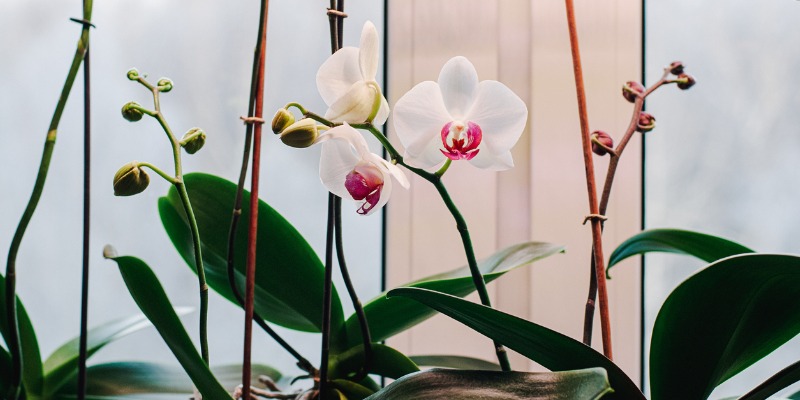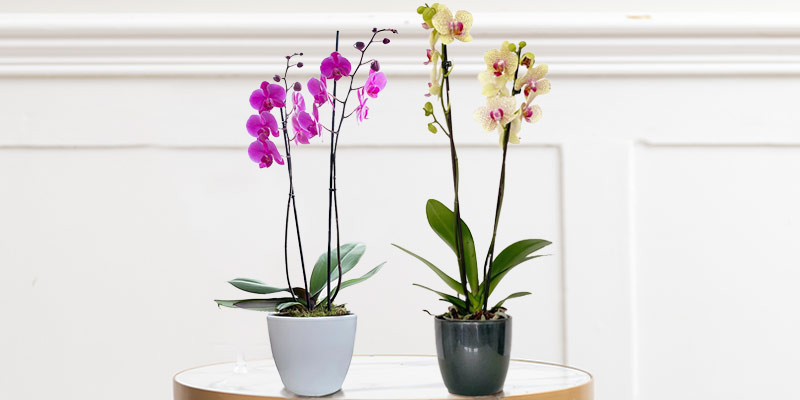Desperate to know how to take care of an orchid because yours keep dying on you? You’re not the only one.
That said, while orchids have a bad rep as the high-maintenance divas of the potted plant world, allow us a moment of bluntness: we reckon that saying about bad workmen blaming their tools applies to orchid care too. Look after your orchid properly, and your orchid will look after you. We’re here to show you how.
There are some 28,000 species of orchids, all with different needs, but our handy guide focuses on the sculptural phalaenopsis orchids that dominate our delivery range. The ideal beginner orchid, with the right TLC, they can last for years when potted, or up to three weeks in a vase.
Why is my orchid dying?
We’re going to have a quick look at some of the most common reasons your orchid might be struggling.
Bud Blast
Bud blast – when a flower dies before or shortly after opening – is typically caused by your orchid suffering environmental shock. It could be struggling with rapid changes in temperature, such as from turning radiators on and off, or it may be too close to a bowl of ripening fruit emitting ethylene gas.
Unhealthy Orchid Leaves
Limp, shrivelled, yellow, brown or black-spotted leaves are all signs of an unhappy orchid, and usually the result of under or overwatering (the latter damages the roots, meaning they can’t absorb water).
The solution? Trimming off any dodgy leaves to reduce the risk of infection, repotting (more on that below) and reading our orchid watering tips carefully (ditto).

Orchid Pests
Pesky aphids could also be to blame for orchid problems. These mini brown or green bugs feast on the sugary sap that orchids produce. You’ll often be able to spot them, but they’re camouflage pros. They tend to attack the newest, most tender shoots first, before reproducing quickly. Stop them in their tracks with an insecticide or non-chemical alternative such as rubbing alcohol.
Other pests include mealybugs and spider mites. Mealybugs are visible to the naked eye – they look a little like tiny white woodlice – and tend to hide in the nooks and crannies of plants. Spider mites are harder to see, but an infestation will make your orchid’s leaves turn silvery, and you might also spot small webs. Spritz them with rubbing alcohol and brush the leaves to get rid of them.
Orchid Care Tips
Now we’ve covered some of the common problems, read on for how to grow an orchid that is not only surviving, but thriving.
Where is the best place to put an orchid in your house?
Orchids hail from the tropics, so our Great British weather can put them in a sour mood (we all know the feeling, right?). They crave hot and humid conditions, which aren’t exactly a regular occurrence in these green and pleasant lands. However, they’ll be happy enough in your kitchen or bathroom, where frequent steam from cooking and showering helps to replicate their preferred habitat.
Orchids are similarly fussy when it comes to light. They’ll throw a strop in shade, but don’t like strong sun either. The best compromise is a north or west-facing windowsill that offers bright yet indirect light and won’t get colder than 18°C, nor hotter than 26°C. The natural drop in temperature at night sparks blooming, so don’t trap your orchid behind heavy curtains. Keen to know that your hard-to-please orchid is happy? Look at its leaves: if they’re bright green, it’s getting enough light.

How often should you water an orchid?
Orchids like their bedding moist, but not wet, so check it every few days, especially in the summer. Typically, they’ll need watering every 7-10 days or so, but this can change depending on their environment and the time of year.
They won’t turn their noses up at tepid tap water, but prefer softer rain water if possible. It’s easiest to water your orchid over a sink so that any excess can drain out and be washed away, without causing mess.
How to make an orchid grow a new spike
Don’t throw your orchid away once the blooms fall off (usually after a few months). Repot it into some fresh, nutrient-rich bedding and trim the stem halfway down, just above a node (those bobbly bits), while it’s still green. This should encourage a new spike to grow, with blooms hopefully emerging two to three months later.
If your orchid is small, or you notice that its leaves have wilted, cut the stem at its base to allow it more recovery time before reflowering. Nurse it back to health with careful watering and fertilising. Specific orchid feed is available, but always follow the instructions on the back of the bottle so your plant doesn’t get too full!

Repotting Orchids
Orchids should only be repotted once every 18 to 24 months, and never while they’re flowering. Most grow on trees in the wild, meaning they prefer a blend of fir bark, sphagnum moss, coconut husks and charcoal, which you can buy pre-packed from garden centres, to regular soil. If possible, use a clear pot that lets sunlight in, as phalaenopsis orchids can photosynthesize through their roots! Clean it thoroughly first, with boiling water, as orchids are prone to disease. Don’t use a huge pot either – you only want to upsize to a pot an inch or two wider.
If you aren’t sure whether to give yours a new home, look for roots that are either hanging over the pot, meaning more space is needed (no more than an inch or so, or the plant will focus more on growing its roots than its flowers), or rotting, suggesting its current bedding is no longer draining effectively. If all looks well, leave it be.
Representing sophistication and strength, orchids make wonderful presents, including for yourself! Our gift-wrapped potted orchids start from just £19.99, or why not treat that special someone to an orchid subscription from £25 a month? Browse our stunning range today.





